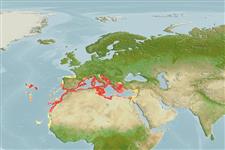Common names from other countries
>
Gadiformes (Cods) >
Phycidae (Phycid hakes)
Etymology: Phycis: Taken from Greek, phykon = seaweed; because of the habits of this fish that lives hidden among them (Ref. 45335).
More on author: Linnaeus.
Environment: milieu / climate zone / depth range / distribution range
Ekologi
laut bentopelagis; nir-ruaya; kisaran kedalaman 13 - 614 m (Ref. 4517), usually 100 - 200 m (Ref. 1371). Subtropical; 45°N - 13°N, 32°W - 36°E
Northeast Atlantic : Bay of Biscay to Morocco, south to Cape Verde, and including off-lying islands. Also in the Mediterranean and the Azores.
Length at first maturity / Size / Weight / umur
Maturity: Lm 36.0, range 32 - ? cm
Max length : 65.0 cm TL jantan/; (Ref. 12382); common length : 25.0 cm TL jantan/; (Ref. 1371); Berat maksimum terpublikasi: 3.9 kg (Ref. 40637)
Duri punggung (Keseluruhan (total)) : 0; Duri dubur: 0. Elongated pelvic-fin rays reaching at most to the origin of the anal fin. Body color is brownish-red dorsally, becoming paler ventrally. Vertical fins distally dark, sometimes with a pale margin.
Found on hard and sandy-muddy bottoms near rocks at 100-650 m, but sometimes taken at greater depths (Ref. 1371). Nocturnal, hiding between rocks during the day (Ref. 1371). Feed on small fish and various invertebrates (Ref. 1371).
Cohen, D.M., T. Inada, T. Iwamoto and N. Scialabba, 1990. FAO species catalogue. Vol. 10. Gadiform fishes of the world (Order Gadiformes). An annotated and illustrated catalogue of cods, hakes, grenadiers and other gadiform fishes known to date. FAO Fish. Synop. 125(10). Rome: FAO. 442 p. (Ref. 1371)
Status IUCN Red List (Ref. 130435)
CITES (Ref. 128078)
Not Evaluated
ancaman kepada manusia
Harmless
penggunaan manusia
Perikanan: nilai komersial kecil
Alat, peralatan
laporan khas
muat turun XML
Sumber internet
Estimates based on models
Preferred temperature (Ref.
115969): 13.3 - 16.2, mean 14.9 (based on 84 cells).
Phylogenetic diversity index (Ref.
82804): PD
50 = 0.6255 [Uniqueness, from 0.5 = low to 2.0 = high].
Bayesian length-weight: a=0.00631 (0.00523 - 0.00762), b=3.15 (3.09 - 3.21), in cm Total Length, based on LWR estimates for this species (Ref.
93245).
Trophic level (Ref.
69278): 4.3 ±0.3 se; based on diet studies.
Daya lenting (Ref.
120179): sedang, Waktu penggandaan populasi minimum 1.4 - 4.4 tahun (K=0.19).
Fishing Vulnerability (Ref.
59153): Moderate vulnerability (45 of 100).
Climate Vulnerability (Ref.
125649): High to very high vulnerability (68 of 100).
